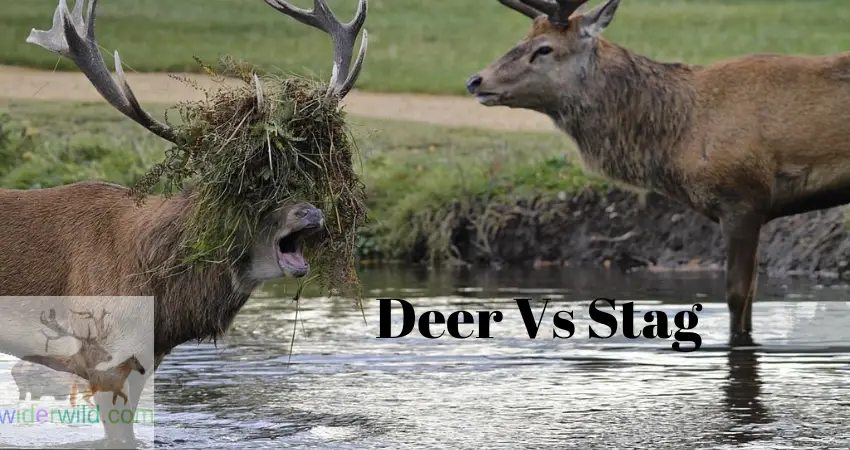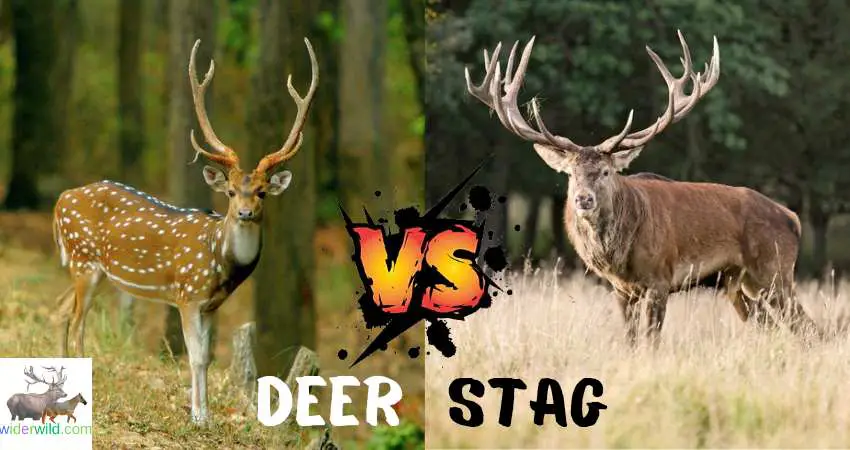Deer and stag are both members of the Cervidae family and share similarities in appearance and behavior. In the wild, deer refers to any undomesticated member of the Cervidae family, including species like white-tailed deer and red deer.

Enhance your confidence with DrGenics New York Stag 9000 Delay Spray—made in Germany for premium quality. Get your two-bottle pack today and experience long-lasting performance!
On the other hand, stag specifically refers to male deer, often distinguished by their large, branching antlers, while female deer are called does. Stags are known for their impressive size and imposing antlers, which they use to establish dominance during mating season.
Both deer and stags are herbivores, primarily feeding on vegetation such as grasses, leaves, and shoots. While they share many similarities, the term “deer” is more inclusive, encompassing both males and females, whereas “stag” specifically refers to male deer.
Understanding The Difference
Deer and stag are two terms often used interchangeably, but they refer to different animals. Deer is a general term that encompasses various species of the Cervidae family, known for their elegance and agility.
They typically have slender bodies, long legs, and branching antlers, which are mainly found in males.
Stag, on the other hand, specifically refers to a male deer, usually of the red deer species. The term ‘stag’ is often used when addressing the male deer during the rutting season, which is the mating season.
Males, or stags, engage in fierce battles to establish dominance and reproductive rights. This period is characterized by the impressive size and shape of their antlers.
| Deer | Stag |
|---|---|
| Includes various species of the Cervidae family | Specifically refers to a male deer, usually of the red deer species |
| Have slender bodies and long legs | Engages in fierce battles during the rutting season |
| Both males and females can have antlers, but they are more prominent in males | Impressive antlers, particularly during the rutting season |
Deer is a broader term encompassing multiple species, stag specifically refers to a male deer, particularly during the rutting season. Knowing these distinctions can help us better understand and appreciate these magnificent creatures.
Characteristics And Appearance
The deer and stag are both majestic animals commonly found in various parts of the world.
Deer, with their slender bodies, are known for their agility and grace. These herbivores typically have a height ranging from 3 to 4 feet and can weigh anywhere between 100 to 300 pounds.
They possess a beautiful reddish-brown coat and have excellent camouflage capabilities in their natural habitat.
Stags, on the other hand, are male deer that are known for their impressive antlers. These antlers grow and shed annually, making them a prominent feature during the mating season.
Stags are usually larger compared to female deer, with a height of around 4 to 5 feet at the shoulder.
In terms of appearance, the key difference between deer and stags lies in their antlers, with stags having elaborate and branched antlers that can span up to 3 to 4 feet wide.
Habitat And Behavior
Deer and stags have different natural habitats and behavior patterns due to their respective environments. Deer are generally found in forests, woodlands, and grasslands.
They are adaptable creatures and can be found in various regions around the world. Deer are known for their grazing habits, feeding on vegetation such as grass, leaves, and shoots. They are also skilled runners and use their speed and agility to escape predators.
On the other hand, stags, which are mature male deer, have distinct behaviors and habitats. Stags typically reside in areas with dense vegetation, such as forests and thickets.
They establish territories and engage in rutting behavior, which involves fighting with other males to establish dominance and gain mating rights.
The environments in which deer and stags live greatly influence their behavior. Deer living in more open spaces may have to rely on camouflage techniques to avoid predators, while those in dense forests may rely more on their senses, such as hearing and smell, to detect potential dangers.
Stags, due to their territorial nature, may exhibit more aggressive behavior to defend their territories and attract mates.
A Battle Of Strength
Witness the ultimate clash of power as a mighty stag goes head to head with a graceful deer. These majestic creatures battle it out, showcasing their strength and dominance in a thrilling natural spectacle. Discover who emerges victorious in this epic duel of the wilderness.
Unveiling The Physical Abilities Of Deer And Stag
Deer and stag are magnificent creatures known for their strength and grace. Let’s explore their physical abilities to determine the stronger of the two. The belief that stags are more powerful than deer is a common myth.
However, both animals possess impressive attributes that contribute to their strength.
| Deer | Stag |
|---|---|
| They are agile and swift, allowing them to navigate through forests and escape predators. | Stags have large antlers that can grow up to several feet long, which they use for defense during battles. |
| Deer have strong leg muscles that enable them to leap high fences and obstacles with ease. | Stags have a strong physique with well-developed muscles that contribute to their imposing presence. |
| They have excellent senses, including acute hearing and keen eyesight, helping them detect danger. | Stags possess a powerful roar, which they use to intimidate rivals and establish dominance. |
Both deer and stags possess remarkable physical abilities that make them formidable in their own right.
It is essential to recognize and value the distinctive characteristics of each species, rather than solely focusing on determining which animal is more powerful. The true strength of these animals lies in their ability to adapt to various environments and employ effective survival strategies.
The Rut: Display Of Dominance
The rut is a fascinating display of dominance between deer and stag during their mating rituals. This period is filled with intense battles and competition as males try to establish their dominance and secure mating rights. The antlers play a crucial role in these battles.
Antlers are grown and shed every year, and they serve as a visual mark of a male’s maturity and dominance. The size, shape, and number of points on the antlers are all factors that determine the success of a male in these battles.
They are used as weapons to engage in fierce fights with other males, and the winner gets the privilege to mate with the females.
During the rut, males often engage in roaring and parallel walking, showcasing their strength and stamina. They mark their territory with scent and urine, indicating their presence and dominance.
Reproduction And Life Cycle
Deer and stags have distinct reproductive processes. Female deer, known as does, exhibit a polyestrous breeding pattern, which means they go into estrus multiple times during the breeding season.
This is influenced by factors such as photoperiod and nutrition. Does emit pheromones during this time to attract males, called bucks?
The bucks, on the other hand, undergo an annual phenomenon called the rut, where they become more aggressive and territorial. They use various tactics such as vocalization, antler displays, and fighting to establish dominance and access to breeding opportunities.
The reproductive process of stags is similar to that of deer but with some notable differences. Stags, also known as male deer, go through a process called antler growth and casting.
They grow antlers each year, shedding them and growing new ones. The antlers play a crucial role in attracting mates and demonstrating dominance. Stags also engage in vocalizations and sparring to establish their social rank within the herd.
| Deer | Stags |
|---|---|
| Birth as fawns | Birth as calves |
| Maturation into does or bucks | Maturation into stags |
| Polyestrous breeding pattern | Annual rut and aggressive behavior |
| Role of pheromones | Growth and casting of antlers |
The battles and rituals of deer and stag

The battles and rituals of the rut are not only a spectacle for observers but also a crucial part of maintaining the population and genetic diversity of deer and stag.
Natural habitats play a crucial role in determining the behavior and lifestyle of deer and stag. Both species are adapted to thrive in different environments.
Deer are commonly found in various habitats such as forests, woodlands, and open grasslands. They can adapt to different terrains and can be found in mountainous regions as well.
Stags, on the other hand, are primarily found in woodlands and forested areas. They prefer dense cover and are known for their solitary nature.
Deer are known to be gregarious animals, often forming large social groups called herds. These herds are typically led by a dominant male, known as a stag or buck.
Within the herd, there is a hierarchical structure, with dominant males asserting their dominance through displays of aggression and vocalization. Female deer, called does, also exhibit social behavior, forming smaller groups with their calves.
Stags, on the other hand, are more solitary creatures. They establish their territory, known as a “rut,” which they defend vigorously against other stags during the mating season.
Stags use various methods to mark their territory, including scraping the ground, rubbing their antlers against trees, and vocalizing. This territorial behavior is essential for attracting females and ensuring successful reproduction.
Survival Strategies
Deer and Stag have developed a range of adaptations to ensure their survival in the wild. These magnificent creatures have evolved various survival strategies to thrive in their habitats.
Deer, being herbivores, have adapted to their surroundings by developing camouflage. Their light brown fur helps them blend in with the forest floor, making it difficult for predators to spot them.
Deer have sensitive hearing and an acute sense of smell, allowing them to detect the presence of predators from a distance.
On the other hand, Stags, known for their impressive antlers, use this feature for both competition and protection. The antlers serve as a symbol of dominance, intimidating potential rivals.
Fighting off predators is made easier due to the Stag’s antler defense mechanism.
Whenever we come to hunting techniques and evasion skills, Deer rely on their incredible speed, agility, and jumping abilities to escape from predators.
They can reach speeds of up to 30 miles per hour and quickly change direction to confuse their pursuers. Stags, on the other hand, use their impressive size and strength to fight off predators.
Deer and Stag have developed unique adaptations and survival strategies to navigate the challenges of the wild. These remarkable creatures continue to awe us with their ability to thrive in their natural environments.
Hunting And Predators
Deer and stags face various predators in the wild. When they venture into open fields, they become susceptible to attacks from cunning predators such as wolves and coyotes. These predators rely on speed and stealth to close in on their prey.
Another common threat to deer and stags is the mountain lion, known for its ambush tactics. Additionally, bears can pose a significant danger, especially during spring when they are in search of food.
- Camouflaging: Deer and stags blend in with their surroundings, utilizing their natural coat colors to remain concealed.
- Vigilance: They possess exceptional senses and are highly alert, enabling early detection of potential threats.
- Swift Movement: Their lightweight builds allow them to navigate swiftly through dense vegetation, escaping predators.
- Grouping: Deer and stags often congregate in herds, making it harder for predators to single out an individual.
- Warning Signals: They use stomping hooves and release loud snorts to alert others of danger.
Conservation Efforts
Conservation efforts play a crucial role in protecting deer and stag populations. It is important to preserve these species as they are vital contributors to the ecosystem. Conservation initiatives have a significant impact on safeguarding their habitats and ensuring their survival.
One key aspect of conservation is the preservation of natural habitats. By maintaining and protecting their environments, we provide a space for deer and stags to thrive. This includes protecting forests, grasslands, and wetlands that serve as their homes.
Efforts to regulate hunting and implement strict regulations also contribute to conservation.
By managing hunting seasons and imposing limits, we can ensure that populations are not decimated and that sustainable hunting practices are followed. This helps maintain healthy populations and prevents overhunting.
Another important conservation measure is maintaining biodiversity. By protecting other animal and plant species that are part of their ecosystem, we provide a balanced environment for deer and stags to thrive.
Conserving biodiversity helps protect their food sources, shelter, and overall ecological balance.
Conservation efforts are critical for the long-term survival of deer and stag populations. Our responsibility is to protect and preserve these majestic creatures and their habitats for future generations.
Frequently Asked Questions Of Deer Vs Stag
Is A Deer An Elk Or A Stag?
A deer is neither an elk nor a stag. These three animals belong to different species. They are separate species with distinct characteristics.
An elk is a large species of deer native to North America and Eurasia, known for its impressive antlers and size.
A stag, on the other hand, generally refers to a male red deer or fallow deer, which is found in various parts of the world.
So, while there may be similarities between these species, it’s important to recognize that they each have their unique traits and classifications within the deer family.
What Is Male Deer Called?
A male deer is called a “buck”.
What Causes A Deer To Be A Stag?
Deer can become stags through a natural process called antler growth and development. Stags are male deer that have reached sexual maturity and have developed antlers. Antlers are bony structures that grow from the heads of male deer and undergo an annual cycle of growth and shedding.
During the spring and summer months, stags’ antlers begin to grow rapidly due to increased testosterone levels.
The antlers are covered in a layer of velvet, which supplies blood vessels to nourish the growing bone. By late summer or early fall, the antlers reach their full size and the velvet begins to dry up and peel away.
Once the velvet has fully shed, stags enter into the rutting season, which is when they compete with other males for mates. During this time, stags used their antlers as weapons for fighting and establishing dominance.
After the rutting season, typically in late winter or early spring, stags will shed their antlers. This process allows new antlers to grow again in the following year.
So, ultimately, what causes a deer to be a stag is reaching sexual maturity and developing antlers as part of their natural growth cycle.
What Does A Stag Look Like?
A stag is a male deer known for its large size and impressive antlers. They have a muscular body, typically brown fur, and a notable hump on their back. Stags are majestic creatures often seen in forests, and their antlers can vary in size and shape depending on the species.
They have a distinctive mane of shaggy hair around their necks and shoulders. Stags can grow antlers that can reach impressive sizes, with multiple tines branching out from the main beam.
The antlers are shed and regrown each year, typically in the late winter or early spring. Stags are known for their majestic appearance and are often associated with strength and power.
How Long Do Deer And Stags Typically Live?
On average, deer and stags have a lifespan of 10-15 years in the wild. However, some individuals have been known to live up to 20 years or more, depending on factors such as habitat, diet, and predation risks.
Can Deer And Stags Interbreed?
Yes, deer and stags of different species within the Cervidae family can interbreed and produce offspring. However, these hybrid offspring often have reduced fertility and may not survive well in the wild.
Final Thought
Understanding the key differences between deer and stags is crucial for wildlife enthusiasts. While both belong to the Cervidae family, stags are male deer with magnificent antlers. They typically possess a majesty and strength that sets them apart from their female counterparts.
Observing these magnificent creatures in their natural habitat is an awe-inspiring experience for any nature lover.
So, next time you encounter a graceful deer or a majestic stag, take a moment to appreciate their unique beauty and the wonders of the animal kingdom.

